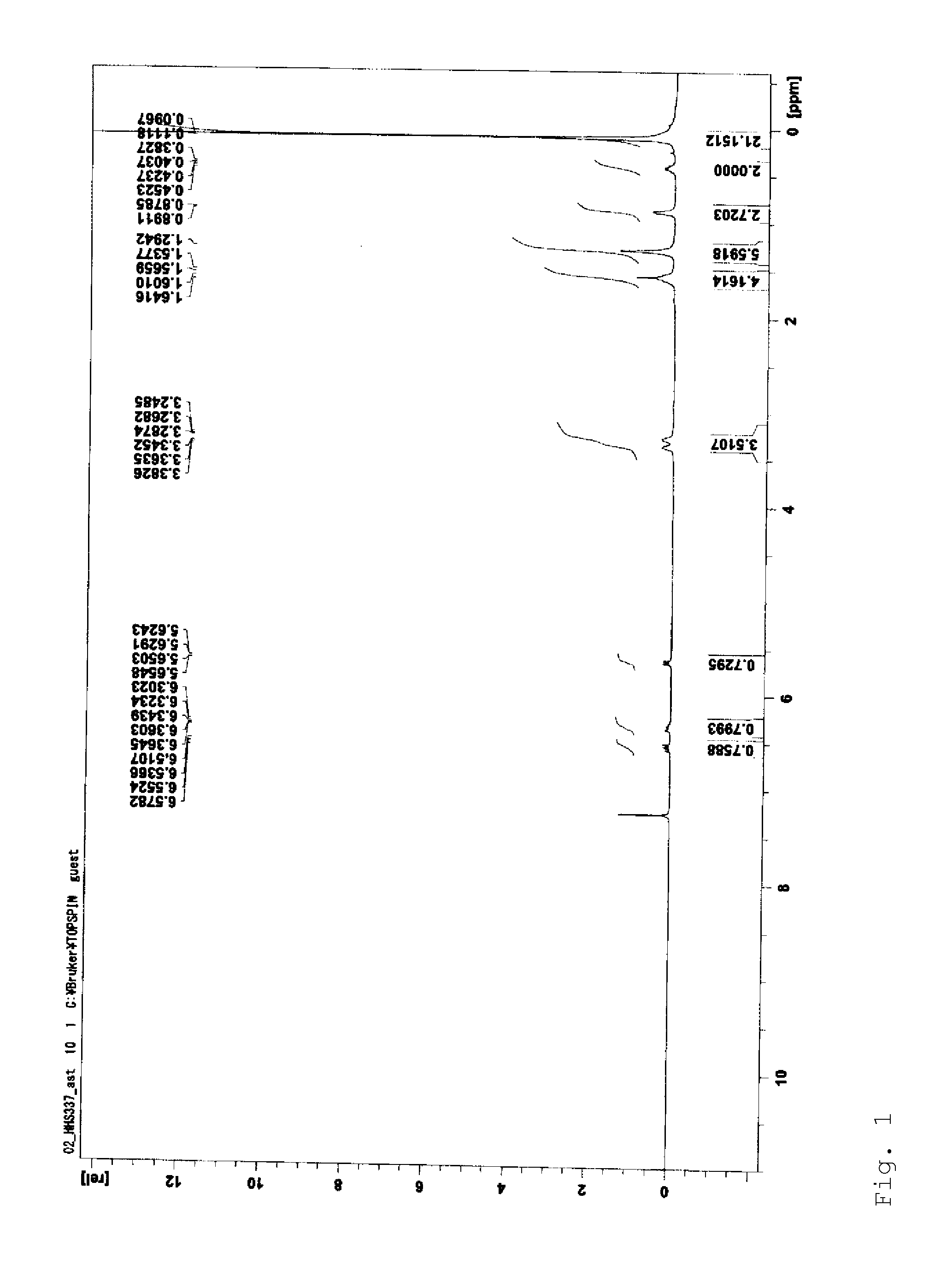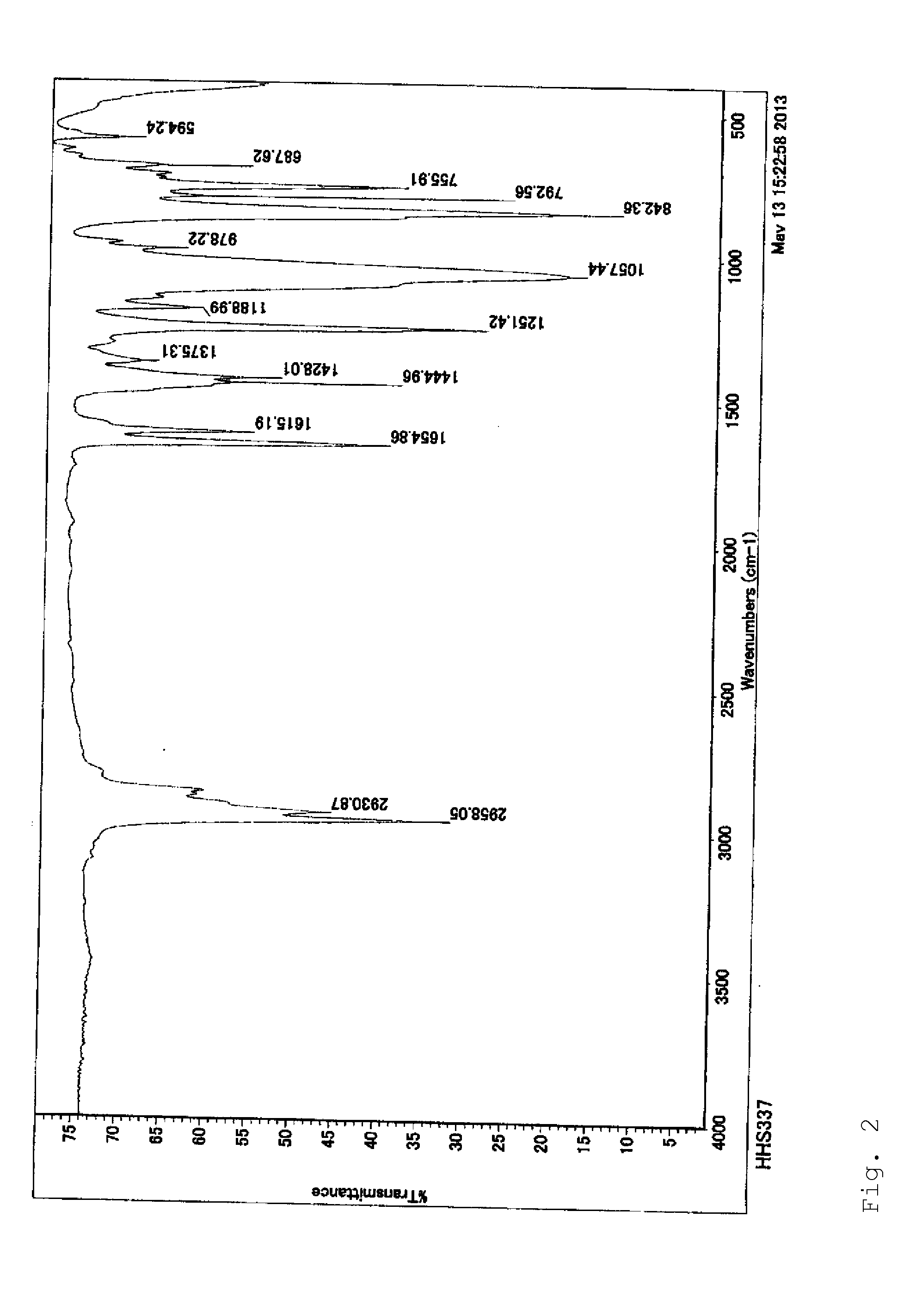Silicone compound having a radical-polymerizable group and a method for the preparation thereof
- Summary
- Abstract
- Description
- Claims
- Application Information
AI Technical Summary
Benefits of technology
Problems solved by technology
Method used
Image
Examples
synthesis example 1
[0053]In a three-necked flask equipped with a thermometer, a stirring device and a nitrogen inflow instrument, were put 1.0 mole of [(CH3)3SiO]3Si(CH2)2Cl, 3.0 moles of n-hexylamine, 0.1 mole of potassium iodide, 3.0 moles of pyridine and 1.0 mole of N,N-dimethylacetamide and, then, heated to an internal temperature of 130 degrees C. with stirring. Disappearance of a signal, 1H-NMR, of CH2 which was next to a chlorine atom of the raw material, [(CH3)3SiO]3Si(CH2)3Cl, was confirmed and, then, the mixture was cooled to room temperature, salts were removed by a filtration through a paper filter, low-volatile materials were evaporated at 50 degrees C. and under a reduced pressure of 10 KPa and the residues were distilled at 140 degrees C. to obtain a very pale yellow and transparent product which was oily at room temperature.
[0054]A molecular structure of the product obtained was analyzed by 1H-NMR and IR to find that the product was a silicone compound represented by the following form...
synthesis example 2
[0058]The procedures of Synthesis Example 1 were repeated, except that n-buthylamine was used in place of n-hexylamine, to obtain a very pale yellow and transparent product which was oily at room temperature. A molecular structure of the product obtained was analyzed by 1H-NMR and IR to find that the product was a silicone compound represented by the following formula. The yield was 76%.
[0059]The 1H-NMR spectra and IR spectra are as described below.
[0060]1H-NMR (400 MHz, CDCl3): δ 0.10 (s, 27H), 0.42-0.51 (m, 2H), 0.85-0.91 (m, 3H), 1.10-1.58 (m, 6H), 2.60 (t, J=8.2 Hz, 2H)
[0061]IR(NaCl): ν 757, 789, 843, 1056, 1250, 1427, 1654, 2972, 3452.
synthesis example 3
[0062]The procedures of Synthesis Example 1 were repeated, except that piperazine was used in place of n-hexylamine, to obtain a very pale yellow and transparent product which was oily at room temperature. The molecular structure of the product obtained was analyzed by 1H-NMR and IR to find that the product was a silicone compound represented by the following formula. The yield was 76%.
[0063]The 1H-NMR spectra and IR spectra are as described below.
[0064]1H-NMR (400 MHz, CDCl3): δ 0.10 (s, 27H), 0.42-0.51 (m, 2H), 1.46-1.58 (m, 2H), 2.23-2.45 (brs, 4H), 2.60-2.92 (m, 6H)
[0065]IR(NaCl): ν 759, 785, 845, 1053, 1189, 1251, 1430, 1653, 2983, 3355.
PUM
| Property | Measurement | Unit |
|---|---|---|
| Temperature | aaaaa | aaaaa |
| Polarity | aaaaa | aaaaa |
| Structure | aaaaa | aaaaa |
Abstract
Description
Claims
Application Information
 Login to View More
Login to View More - R&D
- Intellectual Property
- Life Sciences
- Materials
- Tech Scout
- Unparalleled Data Quality
- Higher Quality Content
- 60% Fewer Hallucinations
Browse by: Latest US Patents, China's latest patents, Technical Efficacy Thesaurus, Application Domain, Technology Topic, Popular Technical Reports.
© 2025 PatSnap. All rights reserved.Legal|Privacy policy|Modern Slavery Act Transparency Statement|Sitemap|About US| Contact US: help@patsnap.com



